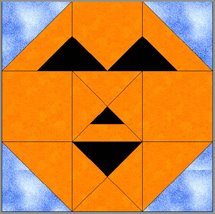Happy Halloween!

Late last night even as the owls were hooting, the cats were howling, and the spiders were crawling, my tame animals and I were safely tucked away busily getting ready for the throngs of children who ring our doorbell and shout “Trick or Treat” every year.
Or something.
The truth is that since we are the only house on a busy street, well, Halloween is just like any other night of the year – dark and quiet on the outside, bustling with activity on the inside.
And this night was no different.
Although we weren’t getting ready for kids to Trick or Treat, we were jumping for joy because CJ from the video shop called and said that the Step-by-Step DVDs would be ready to pick up on Thursday. Yeah!
We were posting the latest pictures of the
http://www.fabric-postcards.com/turkeypostcards.shtml
We were putting the finishing touches on the monthly newsletter and the package of 10 free patterns, which will be posted Nov. 1.
And we were designing a 9 patch pumpkin quilt block. And that was the most exciting event of the evening.
We were so excited, we decided to share the pattern with you – for free!
It’s posted on the Free Quilt Patterns page on the website:
http://www.how-to-quilt.com/patterns/free-quilt-patterns.shtml
Or you can go directly to the pdf file:
http://www.how-to-quilt.com/patterns/9patchpumpkin.pdf
This is an original design, made from squares, triangles, and a baseball home plate. (‘Tis the season – or the end of baseball season anyway.) You’ll see what I mean when you look at the templates for the pattern.
This should be a pretty easy pattern to put together. For the beginning quilters among us, just remember to start by sewing the pieces in each of the 9 patches together, and then sew the patches together, one row at a time. Once you have the 3 rows done, then, sew the rows together. Sound confusing? It’s not really. Just take it one step at a time. Hmmm - - - maybe the pumpkin block is a topic for another Step-by-Step Guide.
Anyway, Happy Halloween! May the Great Pumpkin visit your Pumpkin Patch in Peace J
Happy Quilting!
Penny Halgren
Inspiration and Education for Beginning Quilters
Quilt Greetings Across the Miles
www.Rag-Quilt-Instructions.com
Fast, Fun and Funky Quilts
P.S. Now that we have added a packet of 10 patterns to the newsletter each month, you may wish to consider getting a printed version of the newsletter each month. No, you won’t be getting 60+ pages of quilt patterns in the mail, but you will get the newsletter printed out and a disc with the patterns on it. Plus you get printed copies of all of the newsletters for 2006.


